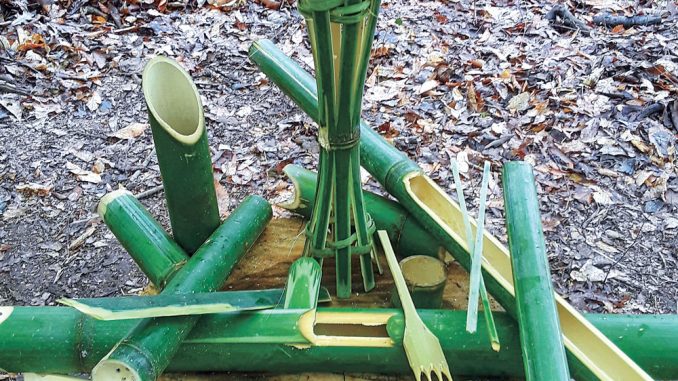
During the weeks of late March and early April 2020, I made a stop in Georgia while on the way to what was supposed to be a bushcraft class at the Randall’s Adventure & Training headquarters in Alabama. The COVID-19 pandemic changed the plan, and I ended up spending two weeks on camp- and skills-building in Georgia with the new offering from ESEE Knives—the Darien Machete.
The Darien Machete
The latest and fourth model in ESEE’s Expat line of knives is the Darien Machete. This piece is made in Central America and is named after its southernmost tip—a no-man’s-land known as the Darien Gap.
The ESEE Knives Expat Darien Machete features a Micarta handle for extended-use comfort and a 12.38-inch blade. Its overall length is 18.18 inches. It weighs just 15.5 ounces and comes standard with a rugged, tan canvas sheath (which wasn’t used during this trip). The blade is made of 1075 steel in El Salvador. The MSRP starts at $100.76.

Making tarp stakes was a snap with the ESEE Expat Darien Machete. Here, the author makes a light chop toward the top and then a diagonal chop for the end that sticks into the ground.
Camp Georgia
Upon arriving in Georgia to stay with good friend Patrick Rollins, lead instructor of Randall’s Adventure & Training, he told me about a thicket of bamboo he had access to not far from his house. We were building up his camp in the woods behind his place, and bamboo would add a whole new dimension to the camp (not to mention the cooking capabilities bamboo offers).
Once we arrived at the bamboo thicket (which we eventually referred to as the “Bamboo Store”), we got to work clearing about 15 poles. I used the Darien to chop through the bamboo and clear it low to the ground; Patrick used a saw. I think the saw was a little faster for this job, but I had really missed using a big blade to chop bamboo. I guess it was the kid in me.

The New ESEE Expat Darien Machete in “Camp Georgia” with a bamboo steamer behind it, cooking up some shrimp and vegetables.
The ‘Bamboo Store’
This bamboo was much wider and taller than the smaller genus (rivercane) in the grass family that’s more common in the Southeast. However, this was proper bamboo, ranging from broomstick to approximately calf thickness. It was bright green—perfect for cooking in and making utensils with. This reminded me of the bamboo I had a chance to work with in the Philippines years ago. But, I now considered myself lucky to be able to work with bamboo again just a couple of hours’ flight away from home.
When we returned to the camp, the first order of business was to reinforce and thatch the lean-to shelter that had been in need of a “woods renovation.” We went along the margin of a small pond to cut some shelter poles ranging from broomstick thickness to about wrist thickness. They were some sort of invasive green tree that had been in need of thinning.
“The Darien was a real chopping machine.”

The ESEE Expat Darien Machete made fast work of these tent stakes. The pointy end is created with a simple diagonal chop, rather than taking the time to sharpen each stake tip
Chopping Tasks With the Darien
The Darien was a real chopping machine.
It was very comfortable during extended use, and it stayed in the hand, thanks to its Micarta grip and handle shape. The handle’s natural arch was quite reminiscent of a long blade found in Southeast Asian cutlery.
It didn’t dawn on me that there was a lanyard hole until much later. I stopped using them on chopping blades years ago. Believe me, the last thing you want is to lose your grip on a chopping tool, only to have it come swinging back at you like a pendulum because of the lanyard. Experiencing this just once will make a believer out of anyone!
We then fixed an old rake whose broken handle was stuck inside. It was an important part of re-thatching the shelter, because it was easier than just using our feet to kick debris into piles or use our hands as rakes. It’s important to work smart, and we had a lot of work ahead of us.


The Darien was used to make notches in the greenwood stakes. This section of any long blade has the most control, and it remains sharper than the chopping portion. The author used it like a conventional fixed-blade knife.
We weren’t exactly rake repairmen, but we went at it. Patrick cut a piece of cedar and, with the help of the Darien’s sharpened spine, I used it to carve off the bark and smooth it out. The Darien was also used to lop off and trim parts of poles and branches. The rake did some serious cleaning up; and, although it wasn’t anything fancy, our rake repair was important.
My set-up in the camp was under a tarp placed over a hammock. The tarp needed to be staked out in at least four places, so I got to work fashioning about 10 stakes I made from the greenwood left over from the lean-to support poles (it’s always good to make more stakes than you need to suit the ground levels, as well as how deep you need to get into the ground). I used the Darien as both a chopping tool and for cutting the notches and trimming the ends that would be hammered into the hard ground. I used the wide, flat part of the blade to lightly hammer in the stakes, making sure to wear leather gloves (for obvious reasons). Some stakes had to be pounded in the rest of the way with a wood baton—also roughly carved with the Darien. The leftover stakes were kept on hand as future replacements or for other projects.

This hardwood wedge was made with the ESEE Expat Darien Machete and was used to split thick logs for the table project. Some firewood was also split with this wedge.

Keeping a close eye on the rice cooking in the bamboo, the author wields the Darien Machete. He learned this way of cooking rice in the Philippines.
One huge task we worked on was retrofitting a table we made a couple of years back. Basically, we needed to rebuild it, and that required splitting thick poplar logs with a hatchet and wooden mallet. This wasn’t a realistic job for the Darien, but I did use it to roughly carve wedges out of oak. It was more of a “team player” than the “MVP” of this Herculean task.
Firewood was needed for the camp, especially because I was staying there almost every night. We had a couple of buck saws and a hatchet in the camp. A smart woodsman uses the best tool for the job, so I wasn’t chopping firewood with a machete unless the wood was finger-thick or smaller. However, I did use the Darien to split a lot of wood, especially for use in the small Uberleben Flat Pack wood stove we had in the camp. Mostly, I split bamboo with the Darien.
The largest, most time-consuming projects were the table and the bamboo roof for it. This required a second trip to the “Bamboo Store” for more poles. We measured and cut the correct length with saws and then split the poles, length-wise, in the middle. The inside nodes were knocked out so the pieces would fit into each other, thereby creating bamboo shingles. I used the Darien for splitting the pieces with a baton and knocking out the nodes. Patrick did the lion’s share of the work, as well as creating the design. The finished project looked like something out of The Swiss Family Robinson!

“Camp Georgia’s” epic table and its bamboo roof. The Darien Machete had a hand in cutting bamboo poles, splitting bamboo for roof shingles and making many of the stakes and cooking devices on the shelves.
Bamboo Cooking
As stated earlier, I encountered bamboo during a jungle survival class I attended at the J.E.S.T. (Jungle Environment Survival Training) Camp in the Philippines. There’s a rich history there that dates back to the early days of the Vietnam War, and it’s where the United States military trained before being deployed. The instructors were absolute masters of bamboo and their big-bladed tools known as “bolos.”
I had to rely on my memory and old photos when it came to reproducing a lot of the bamboo implements I had learned in the Philippines several years back. I remembered carving about five spatulas a night just to keep busy while hunkering around a large star fire lay in the jungle. Eventually, I used them or discarded them when I got back home.
Now, it was time to make some more.

It’s a clean cut with one swipe of the Darien Machete. Bamboo must be chopped at an angle or it’ll crack.

The Darien was used to create a conventional cooking container by chopping two small, narrow, V-shaped notches close to the nodes. Its blade was then used to split the long piece out of the top. This would later cook a delicious shrimp-andveggie omelet.
Like a kid sitting down eagerly to open presents on Christmas morning, that’s how I was with the bamboo. The first thing I did was section a green piece about the size of my forearm, made a slightly angled chop (perpendicular) a few inches from the node and a second chop a few inches above it to get started. With the blade still in the second cut, I lightly pried the blade by turning my wrist counterclockwise until the top (lid) popped out, revealing a chamber for cooking. Then, turning the work over and inserting the blade in the start of the second cut, I sliced it down to the node. This is where the top (lid) would be slid in to hold it in place and also act as a closure point for the lid when cooking rice.
“If everything is done correctly, the rice will be cooked in between 20 and 25 minutes.”
To cook rice, I filled half the chamber with rice and the entire chamber with water, making sure to shake it from side to side to spread out the rice before placing it over the fire. (If everything is done correctly, the rice will be cooked in between 20 and 25 minutes.)

A spatula made with the Darien Machete from a small, leftover piece of bamboo. One end is for cooking and eating rice. The other end is for poking meat and hard vegetables.
Getting it out was another process: I made three angled chops at one end of the cooker chamber. At the opposite end, I inserted the long blade as closely as possible to the top of the chamber surface and slowly pried—as if slicing lengthwise with a drawknife—to peel the length of the top of the chamber open. When it met up with the three chops at the other end, it came free (a few cuts might be needed to disconnect any uncut bamboo fibers).
As an experiment, I wanted to make a bamboo steamer propped up with a “Y” stick holding it in place over the fire. I cut the bamboo pieces I needed with a saw. I selected a thinner piece for the cooking chamber and poked several holes in the node at what would become the bottom. I used a snug-fitting, larger-diameter piece of bamboo that was open at the top for boiling the water. After the bottom section was filled with water and the food added to the cooking chamber in the upper section, the latter was inserted into the open end of the larger piece. I then added a cap to the upper end of the cooking chamber.

Rice was made inside the bamboo. After cooking, the bamboo vessel was split open to eat the rice. The spatulas were also made with the Darien Machete.
As the water boiled, water and steam entered the upper chamber, cooking the fish and vegetables inside. It worked out pretty well.
To open the steamer to retrieve the food, I used the Darien in the same way as with the rice cooker—chopping one end and then slicing the top off the length of the food chamber to access the food.
Making an omelet in bamboo was an easy task for the Darien. The chamber was made in the most common way to cook in bamboo: I chopped a V-cut at a steep angle close to the node at each end of the same side of a length of bamboo. Then, I simply stuck the tip of the Darien into the bamboo at one end and pried the top off down the chamber’s length to the other V-cut. This became the lid to the chamber. I spent a while prepping the vegetables with the Darien, switching to its role as a large kitchen knife.

The cooked omelet, comprising shrimp, eggs, wild green onions, peppers, tomatoes and cheese, was made in green bamboo. The lid was removed to serve it.

The steamer also served as a dish after dinner was cooked. The length of bamboo was opened using the ESEE Expat Darien Machete.
Kitchen Knife
Kitchen duty with a machete might seem far from the norm for most of you reading this. However, in most developing countries, you’ll see the machete being used for butchering, prepping and other kitchen tasks. A walk around a marketplace in Southeast Asia or South America will prove this.
Like a large kitchen knife, a machete is relatively thin for slicing, and it’s wide for scooping up food to transfer, much like a Chinese cleaver. If the primary cutting edge is too thin, the back of a long blade can easily be used to crack through bones. In addition, when using a machete for kitchen duties, the grip often changes to a chef’s grip—commonly known in the culinary world as a “pinch grip” (that is, lightly pinching the top of the handle with the forefinger and thumb where the handle meets the spine of the blade; the remaining three fingers grip the handle loosely). The wide profile makes a machete great for flattening meat or smashing garlic, ginger or nuts. Needless to say, the Darien fit the bill perfectly!
The weeks of the first stages of the pandemic lockdown were not wasted. Although the ESEE Expat Darien machete was a key player in Camp Georgia, it was really about the overall experience and how time was spent, and not so much about the gear. Working with new gear and knowledgeable people will always be a fun and valuable investment of time.

These are just some of the shelter poles for the camp’s lean-to that needed to be repaired. The Darien Machete was used to chop, split and carve bamboo poles for various camp projects.

The Darien Machete comes with a canvas sheath. (Armatus Carry made the author a custom sheath that he used during the camp-building projects.)
The Darien Gap
To get in the spirit of the ESEE Expat Darien Machete, it’s important to understand the origin of its name.
Unknown to most, the Darien Gap is a remote, roadless swath of jungle on the border between Panama and Colombia. Known as a drug-smuggling corridor between the two countries, it’s rarely seen by outsiders. The Darien Gap has an almost mythical quality to it; it’s a mysterious land full of exotic plants, rare wildlife, indigenous people and dangerous paramilitary groups. Largely untouched by the modern world, the Darien Gap is one of the least-visited places on the planet.
Editor’s note: A version of this article first appeared in the September, 2020 print issue of American Survival Guide.






Be the first to comment